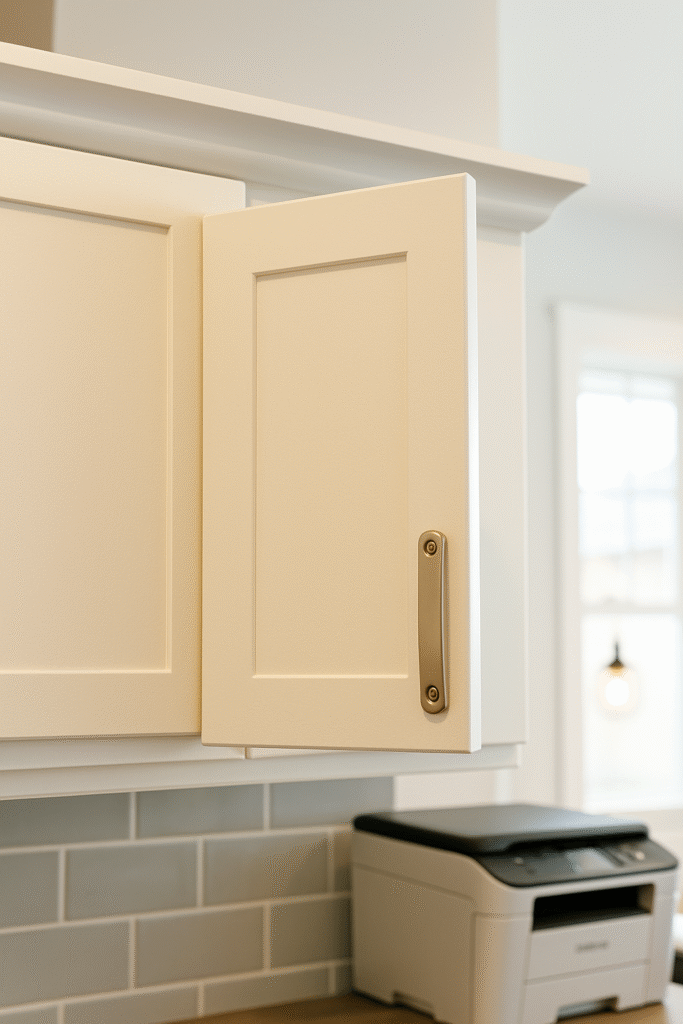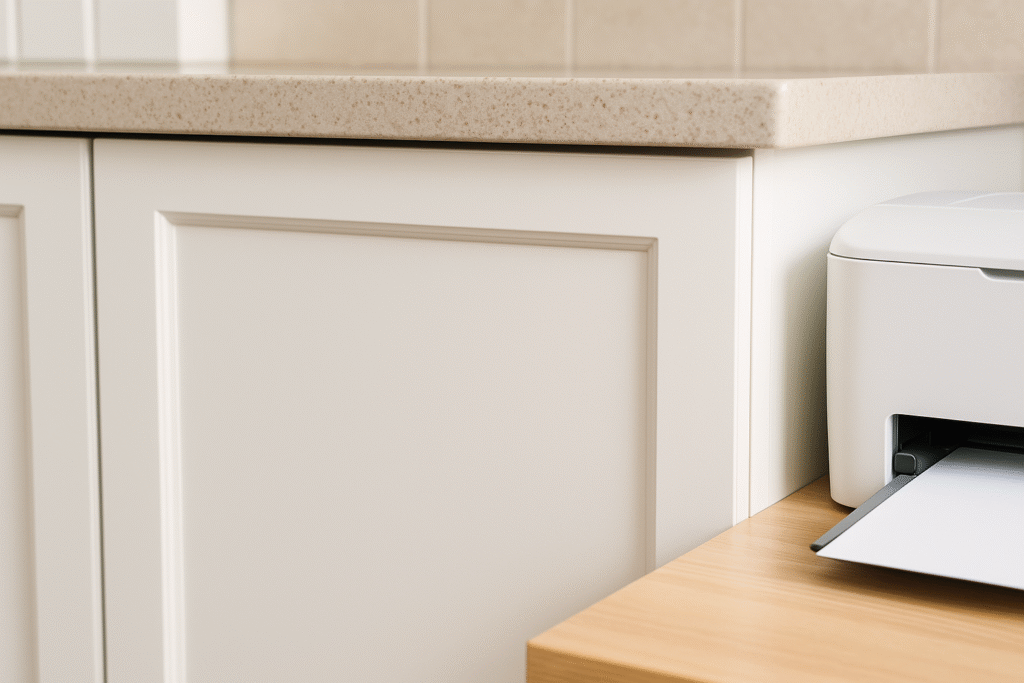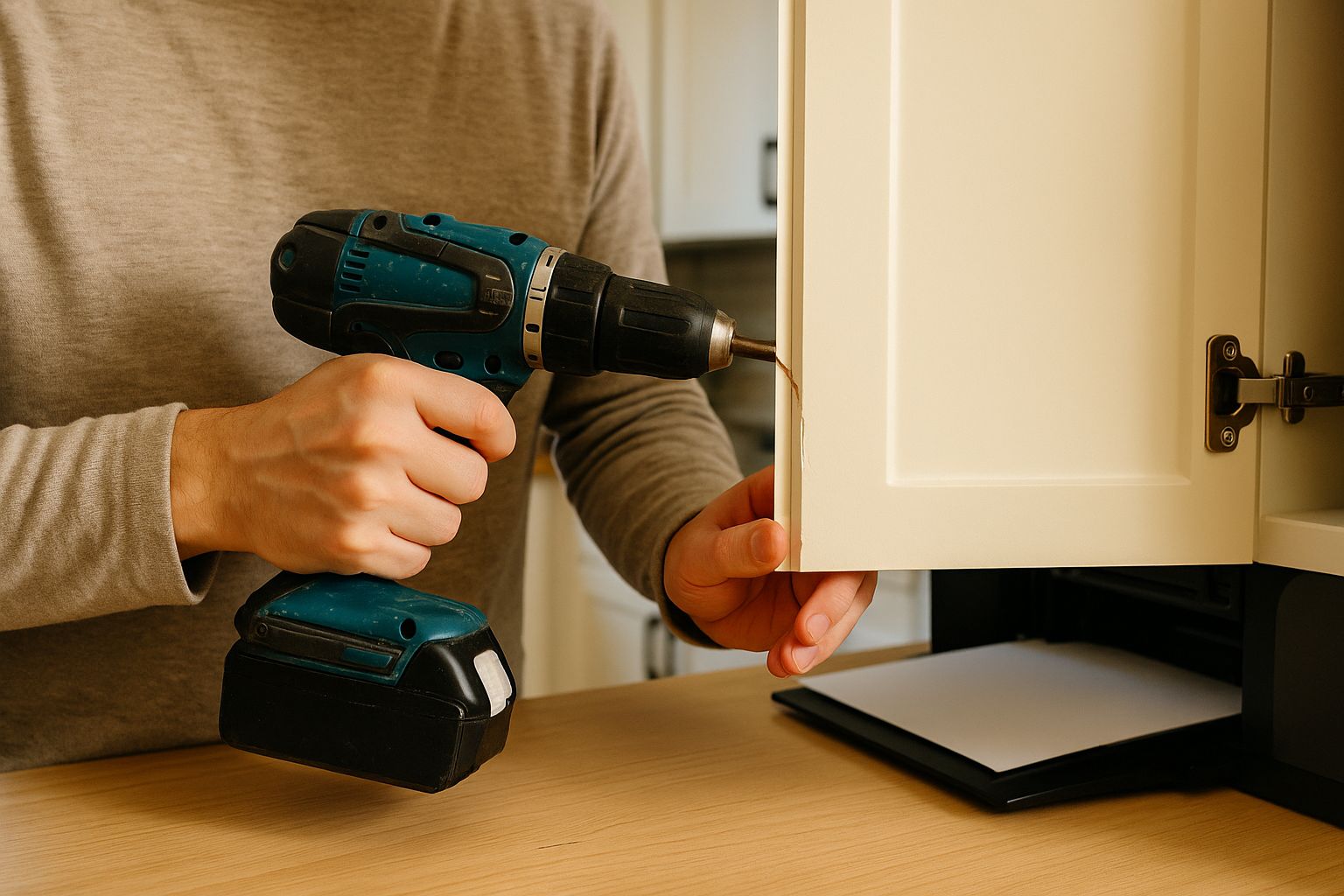Introduction
A wobbly or uneven cupboard door can be both frustrating and unsightly, especially in kitchens where neatness and functionality matter most. Many homeowners eventually search for ways to adjust cupboard door hinges because doors may sag, stick, or fail to close properly over time. This problem is very common and usually results from daily wear, loose screws, or shifting hinges. The good news is that fixing it does not require professional carpentry skills. With a few simple tools and some patience, you can realign your cupboard doors quickly and restore a smooth, seamless look.
Cupboard doors rely on hinge mechanisms to keep them aligned and functioning properly. When these hinges become loose or misaligned, the door may rub against the frame, swing unevenly, or leave visible gaps. Knowing how to adjust cupboard door hinges correctly saves time and prevents further damage. Instead of tolerating a misaligned door or replacing expensive cabinetry, small adjustments are often enough to bring everything back into place. This makes it an essential DIY skill for homeowners and renters alike.
Many people assume that fixing a cupboard door requires replacing parts, but in reality, most problems can be solved by tightening screws, repositioning hinges, or making small adjustments to the alignment. Learning how to adjust cupboard door hinges properly also helps extend the life of your cupboards. If left unattended, poorly aligned doors can put stress on hinges, warp the frame, and even damage the cabinet structure. By taking action early, you prevent costly repairs in the future.
In this guide, you’ll learn the common reasons cupboard doors go out of alignment, the mistakes people make when trying to fix them, and a detailed step-by-step process for achieving a perfect fit. We’ll also cover frequently asked questions and provide prevention tips so you can avoid the problem altogether. By the end, you’ll not only know how to adjust cupboard door hinges confidently but also maintain them for long-term durability. Whether you’re updating your kitchen or fixing a single door, these simple adjustments can make a big difference.
Why Cupboard Doors Go Out of Alignment
To understand how to adjust cupboard door hinges properly, it helps to first know why doors lose alignment in the first place. Cupboard doors are subject to daily use, and over time, small movements can add up to noticeable shifts. One of the most common reasons is loose hinge screws. Each time the door is opened or closed, a slight amount of pressure is applied to the screws, and eventually, they may loosen. Even a small shift in one screw can make a door appear crooked or cause it to rub against the cabinet frame.
Another reason cupboard doors become misaligned is wear on the hinges themselves. Most modern kitchen cupboards use concealed, adjustable hinges designed for easy alignment, but these can still wear out after years of use. As the springs or pivot points weaken, the door may no longer sit flush with the cabinet. In such cases, learning how to adjust cupboard door hinges allows you to compensate for wear without needing full replacement.
Environmental factors also play a role. Kitchens, where cupboards are most often used, experience fluctuations in humidity and temperature. Moisture can cause wooden cupboard frames and doors to expand or contract slightly, creating gaps or uneven spacing. Over time, these subtle changes contribute to misalignment. Without adjustment, the door may start sticking, refusing to close properly, or even damaging the cabinet edge where it rubs.
Improper installation or heavy use can further accelerate the problem. If hinges were not positioned correctly during the initial installation, misalignment issues may show up sooner. Similarly, doors that are used frequently or exposed to weight—such as heavy items being pulled from a cupboard daily—may start to sag faster than those in less-used cabinets. Knowing why this happens prepares you to not only fix the problem but also prevent it in the future.
By identifying the cause of misalignment, you gain valuable insight into how to adjust cupboard door hinges effectively. Whether it’s tightening screws, repositioning hinges, or accounting for environmental changes, addressing the root cause ensures that your adjustment lasts longer. With this foundation, you’ll be ready to move on to the next steps: avoiding common mistakes and applying proper adjustment techniques.
Common Mistakes When Trying to Adjust a Cupboard Door
When learning how to adjust cupboard door hinges, many people make errors that lead to more problems instead of solving the misalignment. One of the most frequent mistakes is overtightening screws. While it may seem logical to tighten everything as much as possible, doing so can strip the screw holes or crack the wood around the hinge. This not only makes the current adjustment ineffective but also weakens the cupboard’s long-term durability. If screws lose their grip because the wood is damaged, you may need to fill the holes and re-drill them, adding unnecessary repair work.
Another common mistake is using the wrong tool. Many cupboard hinges are designed for precise adjustments with a standard screwdriver, but some DIYers attempt the process with a drill or inappropriate tools. This often results in poor control, leading to over-adjustment or even damaged hardware. For anyone looking to adjust cupboard door hinges properly, patience and the correct hand tools make all the difference in achieving a smooth, even finish.

Incorrect adjustment direction is also a frequent issue. Cupboard hinges usually allow for three types of movement: up and down, side to side, and in and out. Homeowners sometimes turn the wrong screw, making the misalignment worse instead of better. Without understanding which screw controls which movement, adjustments can quickly become frustrating. Taking time to identify hinge functions before making changes prevents unnecessary trial and error.
Finally, some people neglect to check the overall alignment before starting. Adjusting only one hinge while ignoring the other can cause the door to sit crooked or place uneven stress on the hinge mechanism. Both hinges must work in harmony, and small tweaks at both points often provide the best results. Skipping this step leads to uneven gaps, doors that won’t close properly, or hinges that wear out faster.
By avoiding these common mistakes, you increase your chances of success when you adjust cupboard door hinges. Using the correct tools, applying the right pressure, and understanding hinge functions all contribute to a more professional, lasting finish.
Step-by-Step Guide: How to Adjust Cupboard Door
Step 1: Inspect the Hinges and Screws
The first step in learning how to adjust cupboard door hinges is to carefully inspect the current condition of the hardware. Many cupboard issues are caused by something as simple as a loose screw, so before making adjustments, it’s essential to assess the situation. Start by opening the cupboard door fully and gently wiggling it back and forth. If there is excessive movement or the door feels unstable, the problem likely lies with the screws or hinge mounting points. Loose screws are often the simplest issue to fix, and identifying them early prevents unnecessary work.
Use a screwdriver to check each hinge screw, both on the door side and the cabinet frame. Tighten any that feel loose, but be careful not to overtighten and risk stripping the holes. If a screw no longer grips because the hole is worn, you can use a simple DIY trick: insert a wooden matchstick or toothpick coated in wood glue into the hole, trim it flush, and then reinsert the screw. This creates a fresh anchor point and allows the screw to hold firmly again. This is a common and effective fix for cupboards that have seen years of use.
While inspecting, also check for signs of hinge wear or damage. Concealed hinges, which are common in kitchen cupboards, may develop play in their springs or pivot points. If a hinge appears damaged beyond adjustment, replacement may be necessary. However, in most cases, hinges are still functional, and the adjustment process will restore proper alignment. Knowing how to adjust cupboard door hinges correctly ensures you get the most life out of your existing hardware before considering replacements.
Finally, ensure that the cabinet frame itself is not warped or damaged. Misalignment isn’t always caused by the door—it can sometimes be the result of the cupboard structure shifting due to humidity, age, or poor installation. If the frame looks solid, proceed to the next step with confidence. By thoroughly inspecting screws, hinges, and the cabinet frame, you lay the groundwork for precise adjustments that will bring your cupboard door back into perfect alignment.
Step 2: Adjust Cupboard Door Alignment
Once you’ve inspected the hinges and screws, the next stage in learning how to adjust cupboard door hinges is to make precise alignment changes. Modern cupboard hinges are designed with adjustability in mind, and most allow for three different types of movement: side-to-side, up-and-down, and in-and-out. Understanding which screw controls which movement is essential to avoid making the misalignment worse. Taking your time during this step ensures the door sits flush with the cabinet, closes smoothly, and looks professionally installed.
Start with the side-to-side adjustment. This screw moves the cupboard door left or right, which helps correct uneven gaps between doors or between the door and the cabinet frame. If your door is rubbing against the side of the frame or leaving an uneven gap, turn the side adjustment screw slowly until the spacing looks even. Small turns make a big difference, so it’s better to work in increments rather than forcing the hinge too far at once. Many people over-rotate here, so patience is key.
Next, focus on the up-and-down alignment. This adjustment is often controlled by loosening the mounting screws on the hinge plate and shifting the hinge slightly before retightening. If your cupboard door appears higher or lower than the neighboring doors, this adjustment will correct the height. Supporting the door while making this change prevents additional strain on the hinges and ensures you achieve accurate positioning. Knowing how to adjust cupboard door height is particularly useful when aligning multiple doors in a kitchen.
Finally, make the in-and-out adjustment. This fine-tunes how close the cupboard door sits to the frame when closed. If the door won’t close fully or sticks out unevenly, the in-and-out screw will bring it flush with the cabinet. Adjust both hinges equally so the door closes smoothly without twisting. Testing the door after each adjustment is important; open and close it several times to confirm the door swings properly and sits even against the frame.
By making careful side-to-side, up-and-down, and in-and-out adjustments, you restore both functionality and appearance. This step is at the heart of knowing how to adjust cupboard door hinges properly, and with patience, it can completely transform the look of your cabinets.
Step 3: Test and Secure the Door
After making your adjustments, the final step in learning how to adjust cupboard door hinges is to test the results and secure everything in place. Even small tweaks can dramatically improve alignment, but confirming that the door operates smoothly is essential before calling the job complete. Testing ensures that your changes have corrected the problem without creating new issues, while securing the hinges prevents them from loosening again in the near future.
Begin by opening and closing the cupboard door several times. Observe whether the door swings evenly, closes fully, and sits flush with the cabinet frame. Pay attention to any rubbing or sticking points, as these indicate that further fine-tuning may be necessary. If you adjusted multiple doors in the same cabinet, check the spacing between them to ensure consistency. Knowing how to adjust cupboard door hinges correctly includes testing for both functionality and aesthetics, as an aligned door not only works better but also looks more polished.
If the door still feels uneven, revisit the adjustments step and make small corrections. Sometimes tightening one hinge slightly more than the other is enough to achieve perfect alignment. Be cautious, however, not to overtighten screws. Over time, repeated tightening can strip the screw holes, reducing the strength of the hinge attachment. If you notice screws that won’t stay tight, consider reinforcing the holes with wooden dowels, glue, or filler material before reinstalling the screws.
Once you are satisfied with the door’s alignment, go over all screws one final time to ensure they are snug and secure. This step helps maintain the adjustment for longer, reducing the likelihood of the problem recurring. For added durability, periodically check hinge screws as part of your regular household maintenance routine, especially in high-use areas like kitchen cupboards. Preventive care is often the difference between a door that stays aligned for years and one that requires frequent adjustments.
By thoroughly testing and securing the hinges, you complete the process of how to adjust cupboard door hinges successfully. This final step ensures long-lasting results, giving you cupboards that are functional, durable, and visually appealing.
FAQs About How to Adjust Cupboard Door
Why does my cupboard door keep going out of alignment?
A cupboard door may repeatedly go out of alignment due to loose screws, worn hinges, or environmental factors like humidity and temperature changes. Kitchens are especially prone to these issues because of moisture and frequent use. Each time the door is opened, tiny movements loosen screws and create gradual shifts. If you want to know how to adjust cupboard door hinges properly, you’ll also need to periodically retighten hardware and check the cabinet structure. Regular maintenance helps keep the door aligned longer, preventing the need for frequent adjustments.
Can I adjust cupboard door hinges without special tools?
Yes, most adjustments can be made with a simple Phillips or flathead screwdriver. Cupboard hinges are designed with built-in adjustment screws that allow side-to-side, up-and-down, and in-and-out movements. While you don’t need specialized tools to learn how to adjust cupboard door hinges, using the correct screwdriver size ensures you don’t strip the screw heads. For more advanced fixes, like reinforcing worn screw holes, you may need basic DIY materials such as wood glue, filler, or matchsticks to restore grip.
What if tightening the screws doesn’t fix the alignment?
If tightening screws alone doesn’t solve the issue, you may need to make hinge adjustments using the built-in mechanisms. Cupboard hinges usually include multiple screws, each controlling a different movement. Identifying which screw controls which adjustment is crucial when figuring out how to adjust cupboard door properly. If hinges are worn or damaged beyond adjustment, replacement may be necessary. In some cases, misalignment is caused by a warped cabinet frame, which may require more extensive repairs.
Should I replace my hinges instead of adjusting them?
Replacement is only necessary if the hinges are damaged, bent, or their springs have worn out. In most cases, knowing how to adjust cupboard door hinges is enough to restore alignment and functionality. Replacing hinges can be more time-consuming and costly, so it should be a last resort after adjustments fail. If your cupboard doors are very old or you notice visible cracks in the hinge mechanism, then replacement may be the more effective long-term solution.
How can I prevent cupboard doors from misaligning again?
Prevention involves proper installation, regular maintenance, and good handling habits. To avoid needing to frequently adjust cupboard door hinges, periodically check screws and retighten them before they become too loose. Keep your kitchen environment as stable as possible, reducing excess humidity that can warp wood. Always close doors gently instead of slamming them, as this reduces stress on the hinges. With these small habits, you can keep your cupboard doors aligned for longer and minimize the need for repeated fixes.
Conclusion
A misaligned cupboard door is one of the most common household annoyances, but it’s also one of the easiest to fix. Once you learn how to adjust cupboard door hinges properly, you’ll realize that most problems stem from simple issues like loose screws or small alignment shifts. With just a screwdriver, a bit of patience, and the right technique, you can bring your doors back into perfect alignment without needing to replace hardware or call a professional. This makes it a practical DIY skill that saves both time and money.
The process is straightforward: inspect the hinges and screws, make small but precise adjustments to side-to-side, up-and-down, and in-and-out alignment, and then test the door thoroughly. By securing everything in place afterward, you ensure the fix lasts longer. Along the way, avoiding common mistakes—like overtightening screws, using the wrong tools, or adjusting only one hinge—is crucial for success. These small details make the difference between a quick fix and one that leads to repeated frustration.

Prevention is equally important. Regularly checking your hinges, handling cupboard doors gently, and keeping your kitchen environment stable can all help prevent future misalignment. Knowing how to adjust cupboard door hinges means you can quickly correct small issues before they become bigger problems, keeping your kitchen looking neat and functioning smoothly. For many households, this simple maintenance task goes a long way toward extending the lifespan of cabinets.
Whether you’re tackling a single door or adjusting an entire row of cupboards, the confidence you gain from mastering this skill will carry over into other DIY tasks around the home. It’s a reminder that not every household problem requires professional intervention—sometimes, the right knowledge and a steady hand are all you need. With this guide, you now have the tools to fix, maintain, and prevent cupboard door misalignment, making your kitchen both more practical and more attractive.
📌 Read Similar Topics
For further reading and expert resources, visit:
Family Handyman: Adjusting Cabinet Hinges,
Lowe’s Cabinet Hinges Guide, and
Wikipedia: Hinge.
Share this:
- Click to share on Facebook (Opens in new window) Facebook
- Click to share on X (Opens in new window) X
- Click to share on LinkedIn (Opens in new window) LinkedIn
- Click to share on Reddit (Opens in new window) Reddit
- Click to share on X (Opens in new window) X
- Click to share on Threads (Opens in new window) Threads
- Click to share on WhatsApp (Opens in new window) WhatsApp





Pingback: Dishwasher Replacement Cost: Smart Ways To Save Big